
Steady growth in the nuclear industry has led to an increase in demand for more accurate, efficient, and reliable detection and monitoring of critical compounds, like Uranium hexafluoride (UF6) assay or Methyl Iodide (CH3i). This has led to the development of new technologies, enhancing the capabilities of molecular spectroscopy. Entities worldwide are developing advanced spectroscopy-based technologies and methods, aiming to decrease accidents with better safeguards, enable the rapid and precise assessment of nuclear plant incidents, and assist organizations like the International Atomic Energy Agency (IAEA) in developing nuclear safeguards. Measuring gaseous radioactive CH3i is very important to quickly assess nuclear plant incidents and avoid shutting down a nuclear power plant, which may cost millions of USD per day. In case of a severe nuclear accident like Three Mile Island or Fukushima, the ability to rapidly and accurately measure CH3i is critical to assess the nature and severity of the incident and gain valuable information about how to respond. Having accurate information when you need it can mitigate costly, disruptive shutdowns and empower facility personnel and inspectors to make quicker and better-informed decisions.
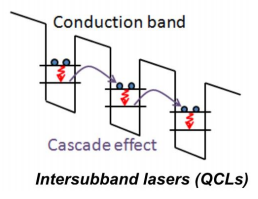 To assist the nuclear industry in the detection and monitoring of these critical compounds, a new class of Distributed Feedback (DFB) Quantum Cascade Laser (QCL) has been developed. While the standard QCL uses InGaAs and AlInAs on an InP substrate – the basis of the optoelectronics telecom industry – this novel QCL technology is based on InAs and AlSb. These materials’ specific properties enabled the expansion of the QCL wavelength range from 4µm to 25µm, which better encompasses the easily discernible absorption peaks of the compounds of interest.
To assist the nuclear industry in the detection and monitoring of these critical compounds, a new class of Distributed Feedback (DFB) Quantum Cascade Laser (QCL) has been developed. While the standard QCL uses InGaAs and AlInAs on an InP substrate – the basis of the optoelectronics telecom industry – this novel QCL technology is based on InAs and AlSb. These materials’ specific properties enabled the expansion of the QCL wavelength range from 4µm to 25µm, which better encompasses the easily discernible absorption peaks of the compounds of interest.
A new class of Distributed Feedback (DFB) Quantum Cascade Laser (QCL)
RPMC Lasers now offers this newly developed class of distributed feedback quantum cascade lasers for the nuclear industry. One such example is a compact, single-mode, DFB QCL that delivers a few mW of optical power at ≈ 628 cm-1 at ambient temperature, perfect for enhanced molecular spectroscopy of Uranium Hexafluoride (UF6). See the charts below, illustrating the tunable wavenumber range and voltage and output power curves. Click Here to read more about this product and a link to download the datasheet, and Contact Us to discuss this exciting new product!
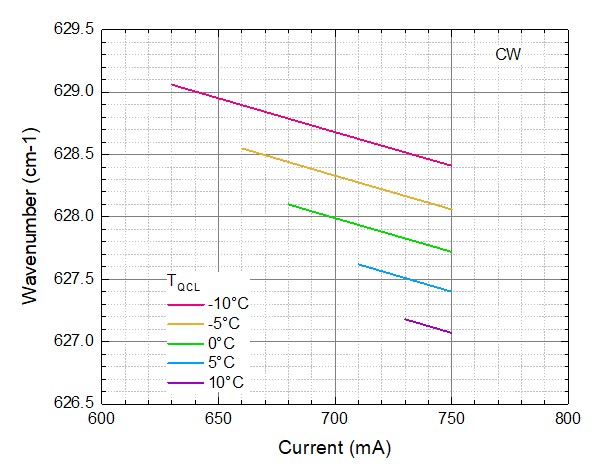 |
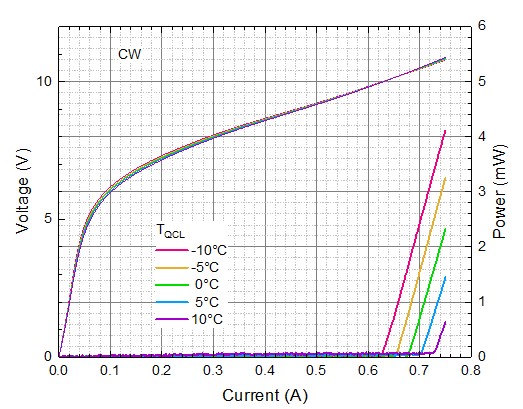 |
|
The curves indicate the laser single-mode emission wavelength as a function of the applied DC current and laser chip temperature. Lasers with slightly shifted wavelength are also available. |
The curves on the left indicate the voltage of the laser as a function of the applied DC current and laser chip temperature. The curves on the right indicate the output power as a function of the applied DC current and laser chip temperature. |

RPMC Lasers also offers a compact, single-mode, DFB QCL that delivers 10mW of optical power at ≈ 885 cm-1 at ambient temperature, perfect for laser spectroscopy of Methyl Iodide (CH3i). See the charts below, illustrating the tunable wavenumber range and voltage and output power curves. Click Here to read more about this product and a link to download the datasheet, and Contact Us to discuss this exciting new product!
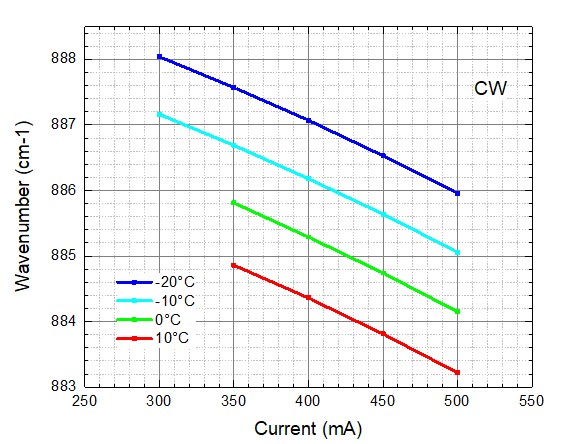 |
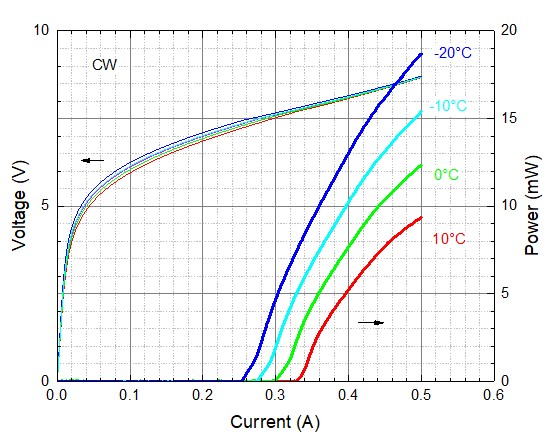 |
|
The curves indicate the laser single-mode emission wavelength as a function of the applied DC current and laser chip temperature. Lasers with slightly shifted wavelength are also available. |
The curves on the left indicate the voltage of the laser as a function of the applied DC current and laser chip temperature. The curves on the right indicate the output power as a function of the applied DC current and laser chip temperature. |
The nuclear industry may also be interested in two other quantum cascade lasers available through RPMC. For the spectroscopy of Neptunium NpF6, a compact, single-mode, DFB QCL that delivers a few mW of optical power at ≈ 624 cm-1 at ambient temperature, and for Plutonium PuF6, a compact, single-mode, DFB QCL that delivers a few mW of optical power at ≈ 619 cm-1 at ambient temperature. Contact Us today to enquire about these and other wavelength options for the detection and monitoring of many different compounds in the nuclear and other industries!
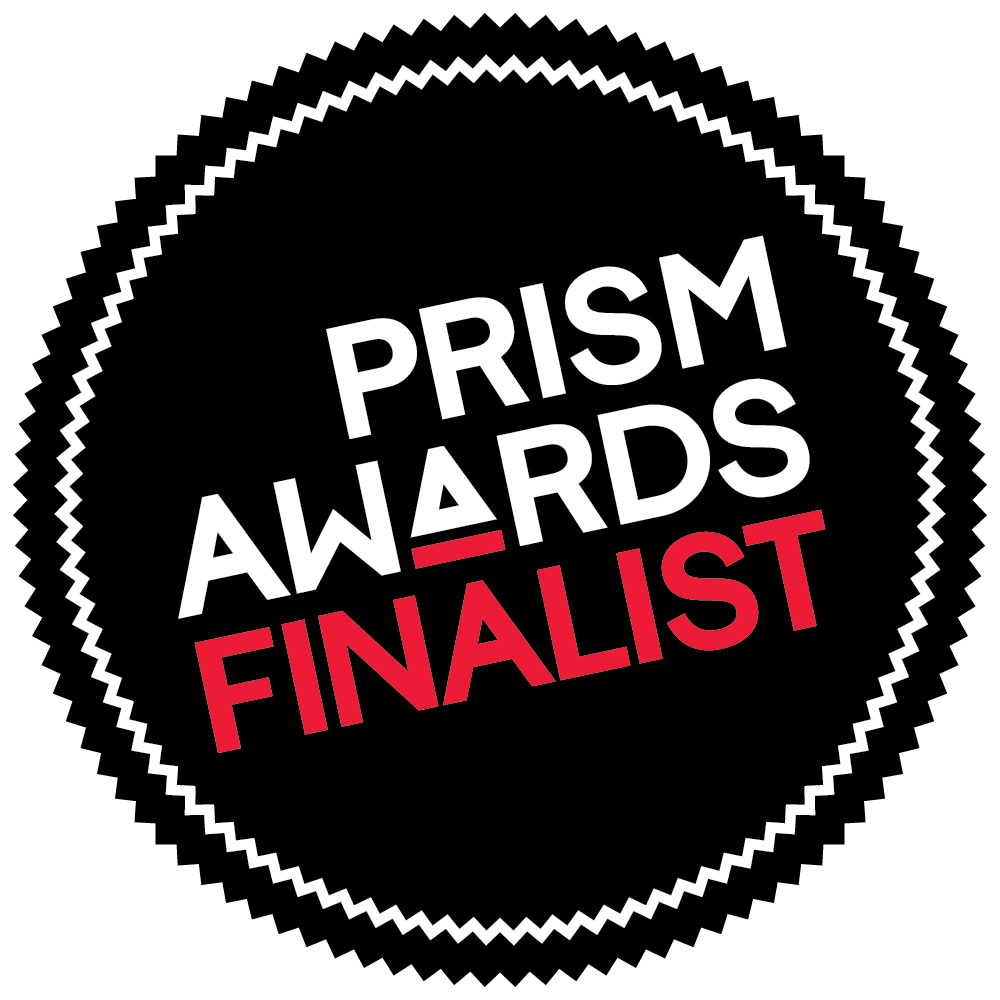
SPIE – 2021 Prism Awards Finalists for Photonics Innovation!
mirSense is a well-known and established entity, with 20 years of expertise in the QCL industry for defense and spectroscopy and now offers this new InAs-based QCL technology. These amazing new QCLs earned mirSense a spot as one of three finalists for the SPIE – 2021 Prism Awards for Photonics Innovation for Smart Sensing. SPIE received a record number of applicants for the 2021 award. Amongst all the competition, mirSense’s new QCL technology put them into the group of the top 3 finalists, a testament to their amazing technology!
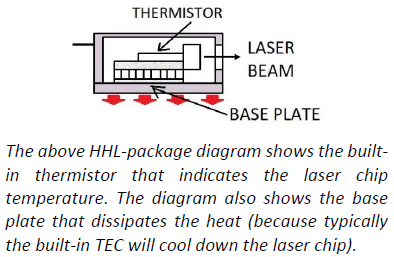
Their groundbreaking UniMir line of long-wavelength, single-frequency DFB QCLs are now commercially available in a sealed High Heat Load (HHL) package, with an integrated collimating lens, thermistor, and thermoelectric cooler (TEC). The UniMir is well suited for integration into systems or as a stand-alone turnkey system for R&D and detection applications. These lasers, which operate in CW or in pulsed mode, emit a maximum power of 10mW (<15µm) at room temperature. By controlling the chip’s operating temperature through the Peltier element inside the laser’s package, customers tune the emission wavelength without mode hopping, while maintaining single longitudinal mode operation.
The technology’s versatility allows access to any wavelength between 10 and 18µm in CW mode and up to 21µm in pulsed mode, opening the way for high-resolution spectroscopy applications in this spectral range, notably for the detection of CH3i and UF6, but also PuF6, NpF6, HCN, BTEX, and many other molecules. Compared to wavelengths produced by previous QCL technology, these new QCLs will enable much stronger absorption rates by these molecules, with less cross interference from other molecules in the 10m-17µm range.
Contact Us About the QCLs from mirSense
Click Here to learn more about these groundbreaking new Quantum Cascade Lasers from mirSense!

mirSense came into being in 2015 after years of developing the QCL technology. They design and manufacture high-power (typically watt-level) diodes in 4.0µm, 4.6µm, 4.8µm, and 9.Xµm wavelengths, and now offer mW level DFB QCLs from 10µm through 17µm. They’re able to handle anything from small-scale development to mass production runs due to their trusted relationships with local suppliers, industrial-oriented manufacturing methods, and agile supply chain. Utilizing their highly skilled team of Ph.D. engineers and proprietary, innovative solutions, based on a robust patent portfolio, mirSense helps further customer’s applications all over the world. |
 |

 SHIPS TODAY
SHIPS TODAY 